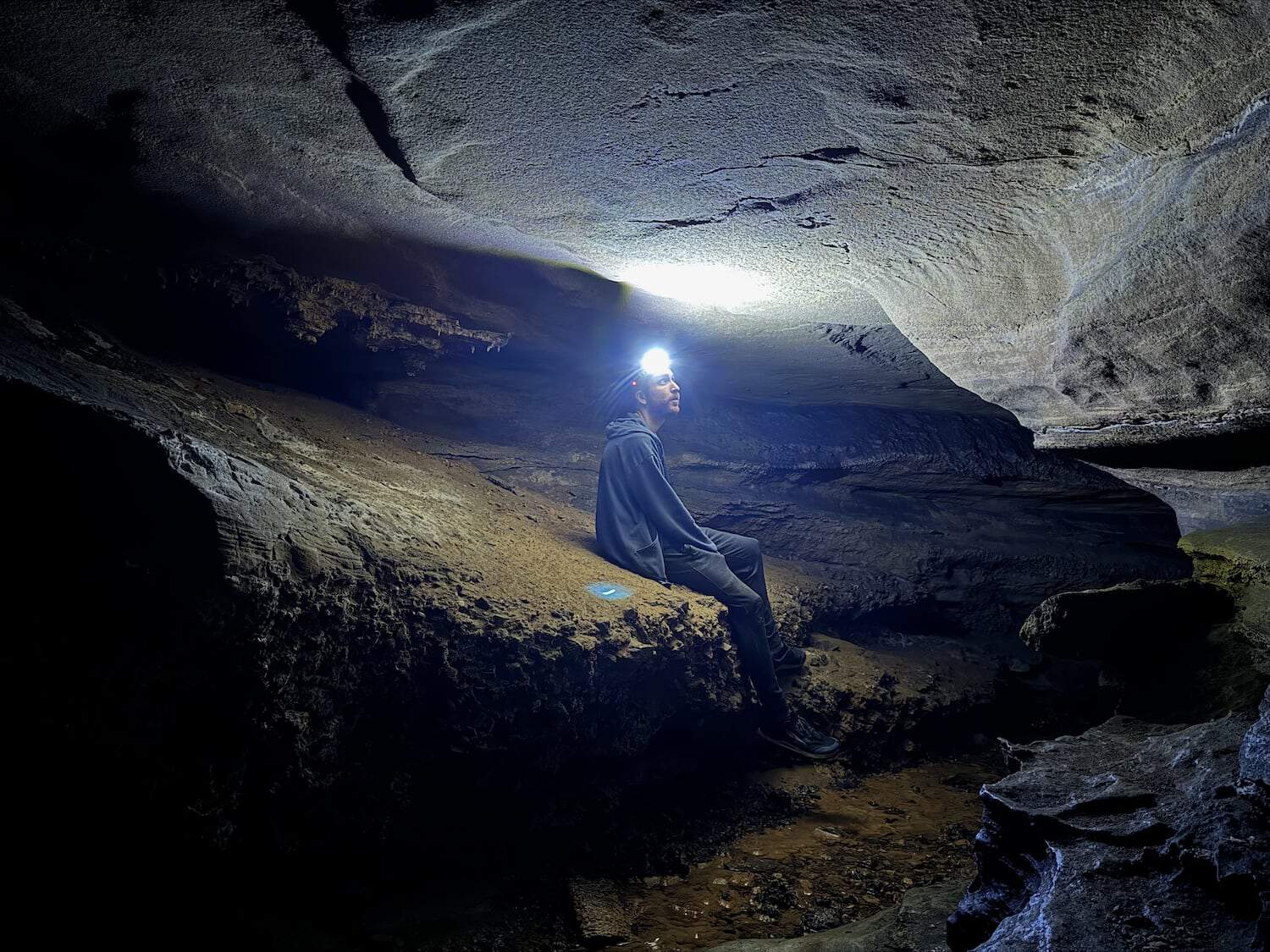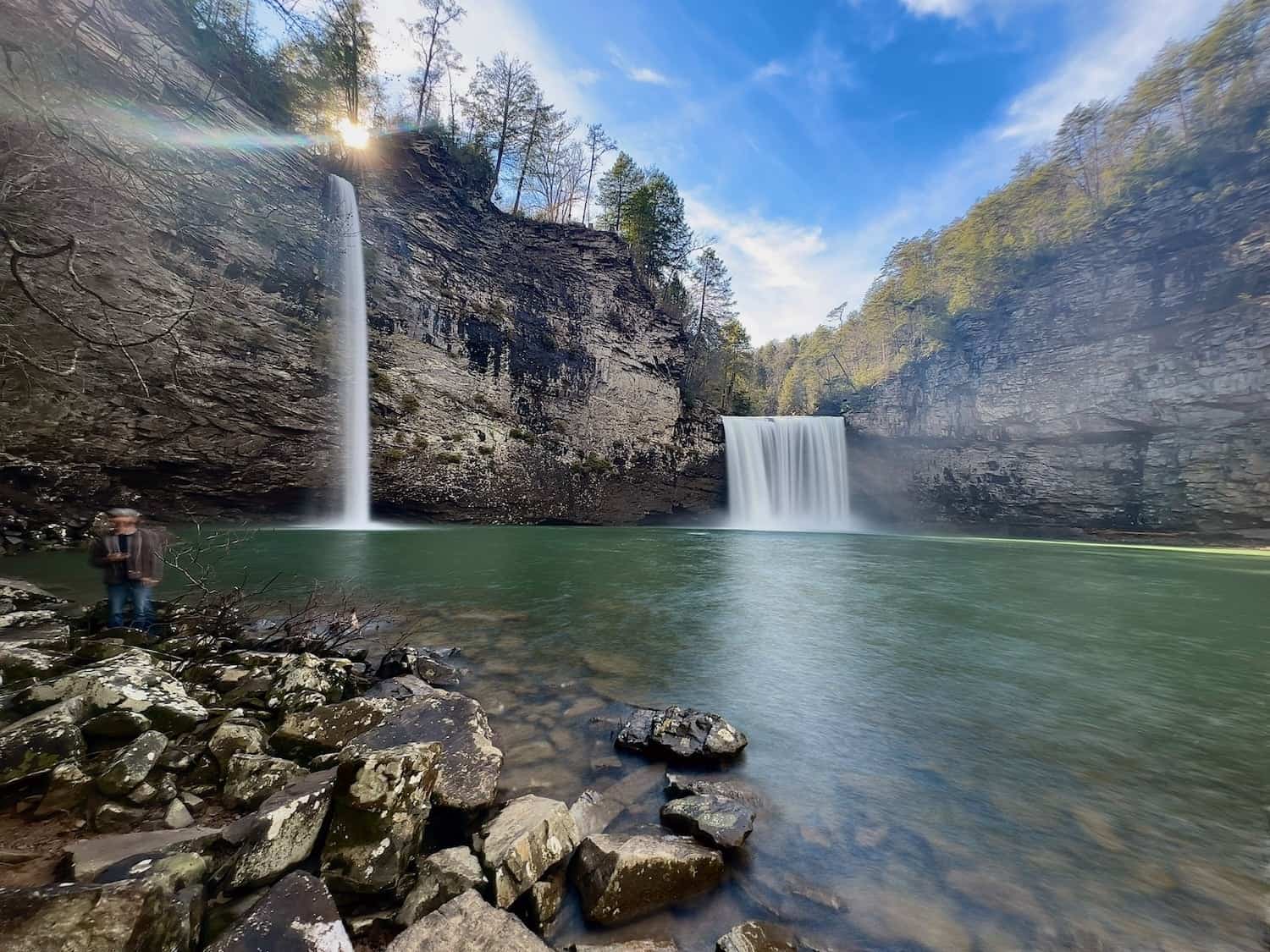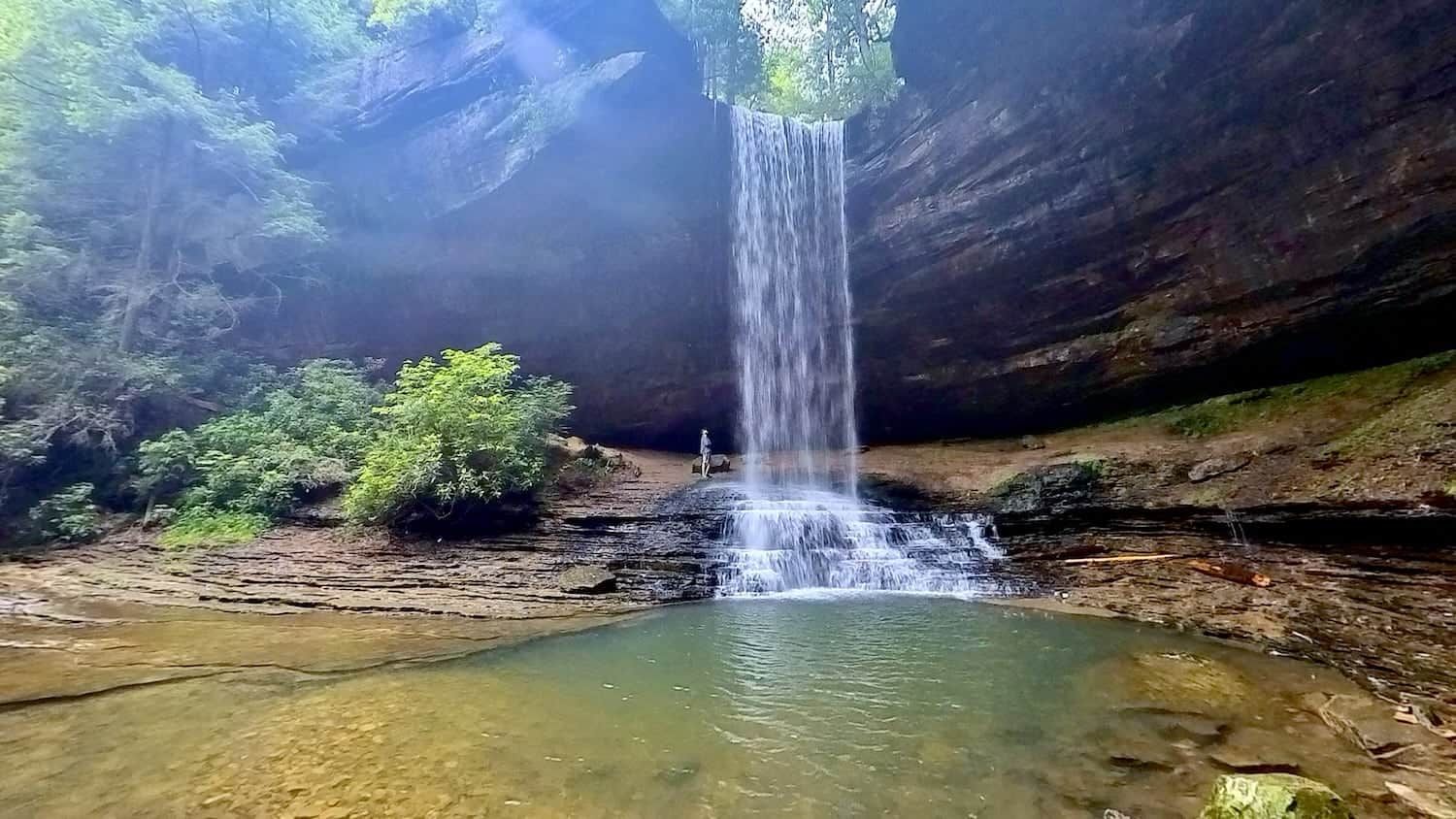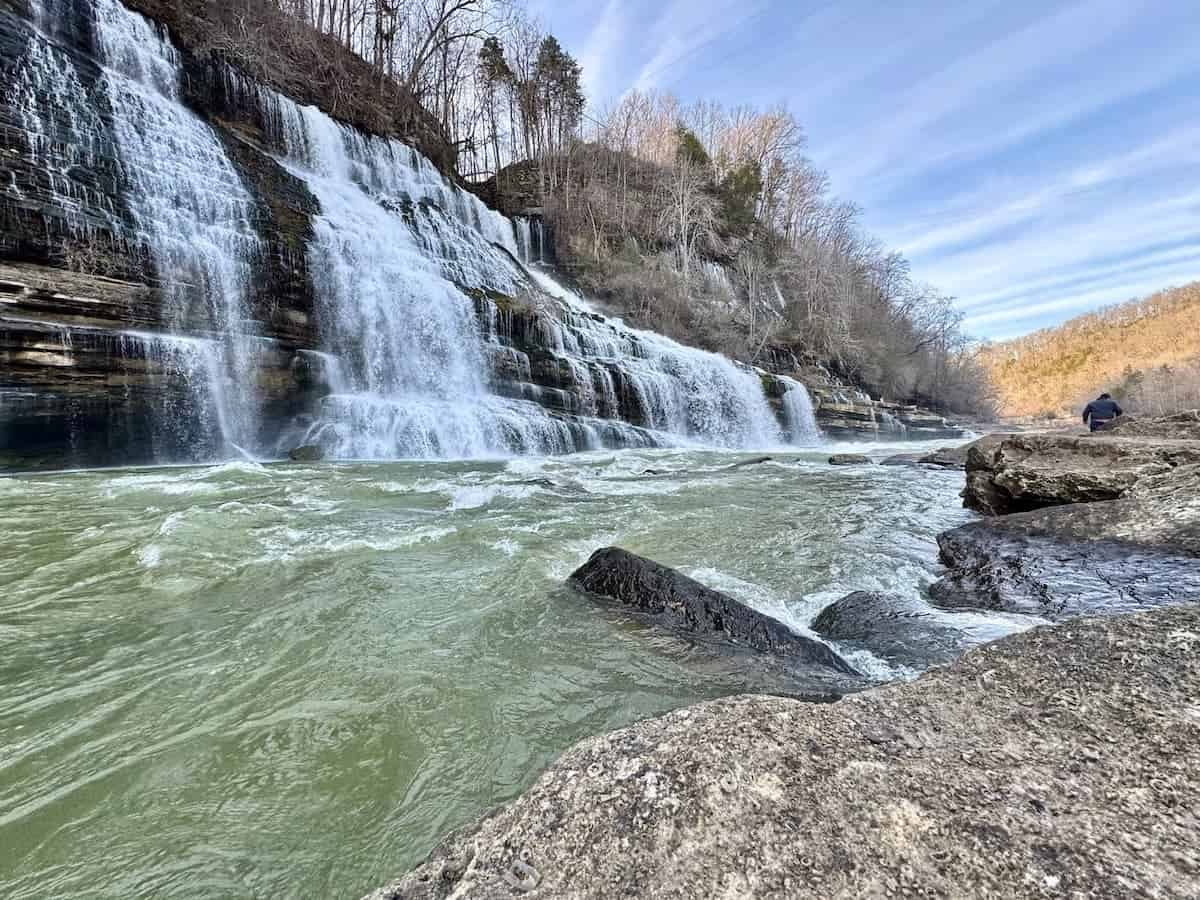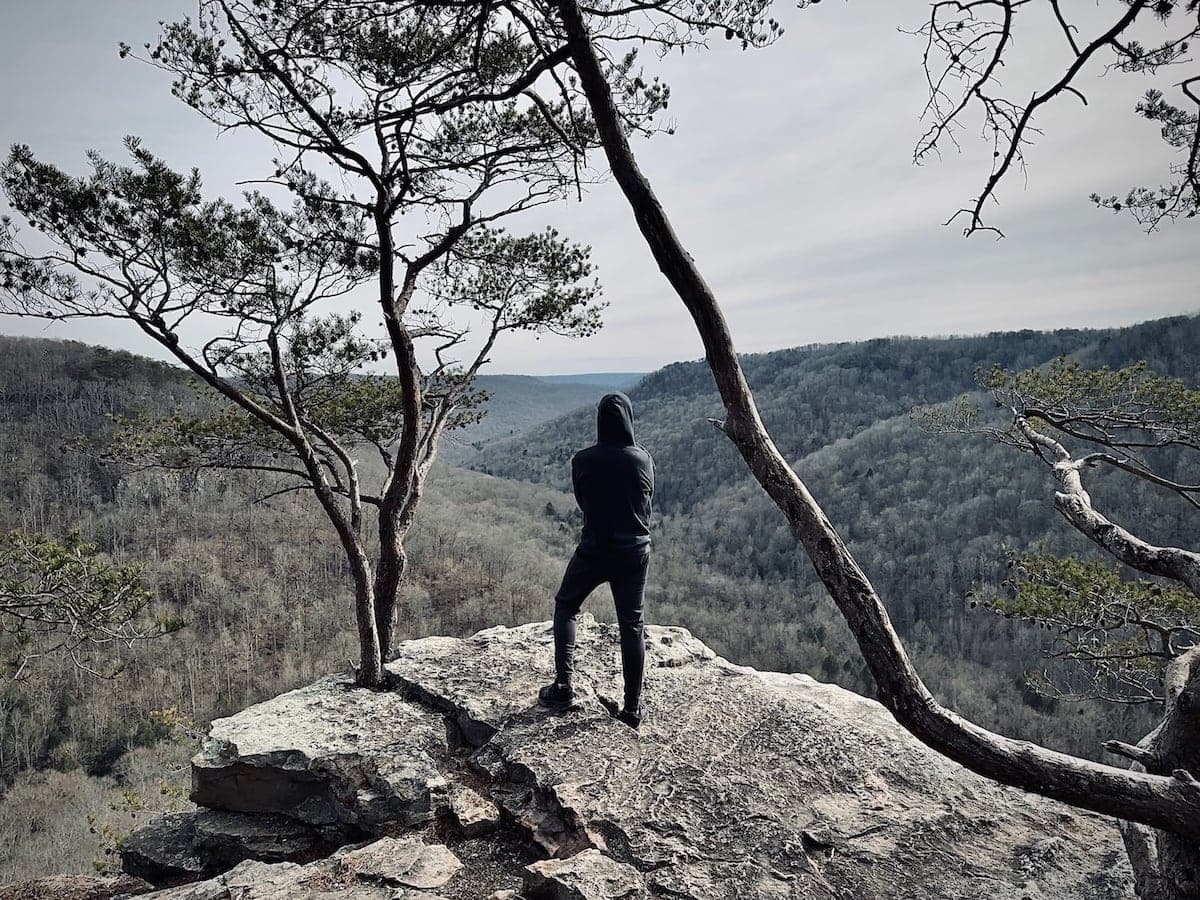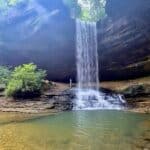New to caving and not sure what gear to buy? Been exploring caves for a while, but feel like your gear could use an upgrade? Looking for great deals on caving equipment? You’ve come to the right place!
I made this guide so cave beginners and experienced veterans alike can benefit from our collective knowledge.
Let’s explore some essential cave gear, non-essential gear, the advantages they offer, and how to get discounts.
Essential Cave Gear
Certain caving gear is optional, but some gear is absolutely essential. Here’s a list of must-have equipment every caver should carry.

Packs/Backpacks
Backpacks are crucial for caving. They provide an efficient way to carry essential gear while keeping your hands free for climbing, crawling, or maneuvering through tight spaces. A good caving backpack is compact yet durable, capable of withstanding harsh conditions like rough surfaces, moisture, and dirt.
Backpacks allow you to store items like food, water, first aid kits, extra batteries, and safety equipment, ensuring you’re prepared for extended trips or emergencies. Additionally, having an organized backpack helps distribute weight evenly, reducing strain on your body and allowing for a more enjoyable and safe caving experience.
A lot of people use a cheap backpack as sharp rocks will wear down any pack, cheap or expensive. Personally, I use a backpack from Nomatic.
If you’re visiting a wet cave, use a waterproof pack and place spare batteries/electronics in a separate waterproof container inside your main pack. You can store electronics and other vital gear in a Nalgene water bottle or a Daren drum to ensure they stay secure and dry. Alternatively, this could be as simple as a plastic baggie or dry bag. Swaygo sells top-of-the-line waterproof packs, such as the Swaygo Sink Pack, which comes in three sizes.
You can store a trash bag in your pack to carry out trash you find in a cave. If people see trash in a cave, they tend to assume that it’s okay to do so, causing more people to leave more trash. Didn’t find trash? After your trip, you can place your dirty clothes in the trash bag to keep your vehicle clean.
Tip: Does your backpack give you back pain? Go to an REI store and ask a staff member to teach you how to ensure your backpack fits you properly so weight is distributed evenly. Or research this on YouTube.
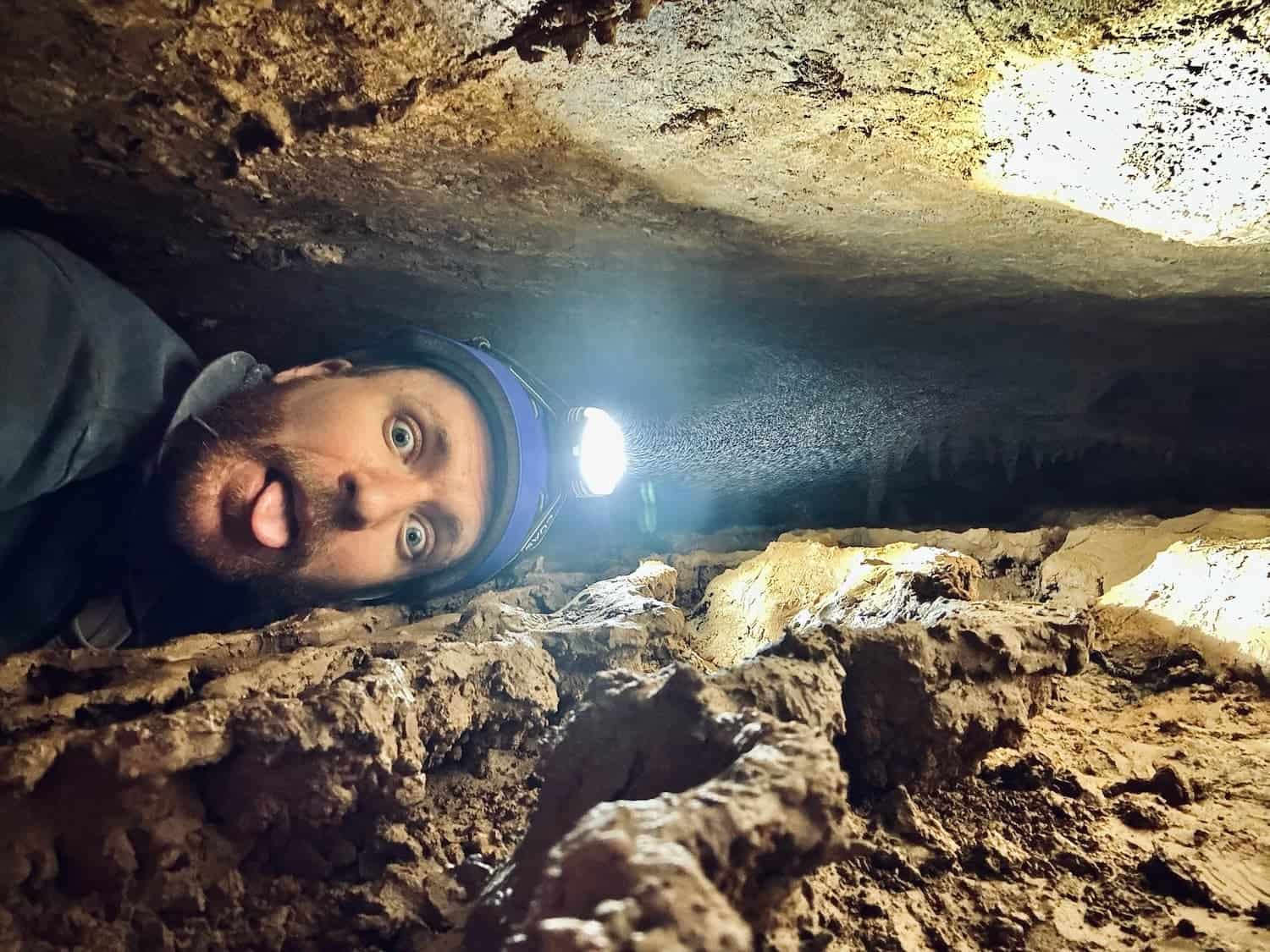
Helmets
A helmet is a vital piece of equipment for caving because it provides essential protection and functionality in the challenging and unpredictable environment of a cave. Here’s why it’s important:
- Head Protection: Caves often have low ceilings, sharp rocks, and narrow passages. A helmet protects your head from bumps, scrapes, and potential injuries caused by falling rocks or accidental impacts.
- Mount for Headlamp: Many caving helmets are designed with a secure mount for a headlamp, ensuring your light source stays stable and directed where you need it, even during movement.
- Prevents Serious Injuries: In case of slips or falls, a helmet can absorb the impact and reduce the risk of serious head injuries, which is crucial in remote environments where medical help may not be immediately accessible.
- Durability in Harsh Conditions: Caving helmets are built to withstand tough conditions, including moisture, mud, and rough handling, making them reliable for extended use underground.
- Comfort and Fit: A well-fitted helmet stays securely in place, allowing you to move freely without worrying about it shifting or falling off during climbs, crawls, or squeezes.
- Safety: Helmets in a bright color make it easier to identify and locate team members, especially in low-light conditions, enhancing overall safety and coordination.
In summary, a helmet is indispensable for caving, offering both physical protection and practical functionality, ensuring a safer and more enjoyable exploration experience.
There are many helmet options, but a general rule of thumb is to get a helmet made for rock climbers or cavers with a chin strap.
Personally, I like the Petzl Boreo Helmet for men (OnRope1) (REI). They have a similar helmet for women under a different name.
Tip: Be careful if buying gear from Amazon. There is proven history of fakes/knockoffs and low quality caving gear being sold on Amazon. For anything safety related, I recommend only purchasing from reputable retailers.
Headlamps
A headlamp is essential for caving because it provides hands-free, reliable illumination in an environment where natural light is absent. Here are some key reasons why it’s important:
- Hands-Free Operation: Caving often requires climbing, crawling, or using tools, so having a light source that doesn’t occupy your hands is crucial for safety and efficiency.
- Consistent Light Source: Caves are pitch dark, and a headlamp ensures you can see your surroundings, navigate safely, and avoid hazards like uneven terrain, sharp rocks, or sudden drops.
- Durability and Reliability: Headlamps designed for caving are typically rugged, water-resistant, and long-lasting, making them dependable in the challenging and damp conditions of caves.
- Adjustable Beam: Many headlamps offer adjustable brightness and beam focus, allowing you to see both close-up details and distant areas. This is vital for exploring caves of various sizes and complexities.
- Backup Safety: A headlamp often serves as a primary light source, but it’s also common to carry spare batteries or an additional headlamp as a backup in case of failure, ensuring you’re never left in the dark.
In short, a headlamp is critical for caving, ensuring safety, visibility, and functionality in an otherwise completely dark and unpredictable environment.
Some headlamps come with a strap so that you can wear them on your head with or without a helmet. Some are removable, so you can also use them as flashlights. Some have a spotlight and a floodlight. Some can shine different colors, such as red, which reduces eye strain and helps you see better in the dark.
If you need an affordable, durable headlamp and want a reliable option without spending hours researching, this headlamp is highly recommended. It is also a great backup light.
Personally, I use the Coast RL35R. You can control the headlamp with your voice, which comes in handy in a tight crawlspace. Popular headlamp brands include Fenix and Zebralight. I like the Coast brand as a reliable yet affordable lighting brand.
Tips
- When caving, you should have a minimum of 3 different light sources and spare batteries!
- If you’re going wet caving, think about getting a water-proof (this is different from water-resistant) headlamp.
- Bring extra batteries. Having your headlamp run out of battery in a cave sucks.
- Make sure you have enough batteries to last longer than the estimated trip time for your trip.
- Battery run times fade over time. Keep that in mind.

Sturdy Boots
Sturdy boots are essential for caving because they provide the necessary support, protection, and grip for navigating challenging underground environments. Here’s why they matter:
- Traction and Grip: Caves often have slippery, uneven, or wet surfaces. Sturdy boots with good grip/tread help prevent slips and falls, ensuring better stability. A common grippy outsole on boots is called GORE-TEX.
- Ankle Support: Uneven terrain and climbing over rocks can strain your ankles. Boots with strong ankle support reduce the risk of sprains or injuries.
- Durability: Caving involves rough conditions, including sharp rocks, mud, and water. Sturdy boots are made to withstand these elements without falling apart.
- Protection: They shield your feet from sharp rocks, debris, and potential hazards like falling objects or jagged surfaces.
- Comfort: Long hours in a cave can be tough on your feet. Well-made boots provide cushioning and reduce fatigue, making the experience more enjoyable.
Investing in high-quality, sturdy boots designed for caving or hiking ensures safety and comfort while exploring underground.
Going in wet caves? Jungle boots that drain (combined with neoprene socks) make a solid wet-caving combo. Jungle boots are designed for humid/wet environments and may be a better option for you if you don’t like leather boots.
Personally, I like wearing hiking boots in a cave, but many cavers prefer wearing wellies (especially in wet caves).
A popular, high-quality hiking boot brand is Salomon. I like the Salomon X Ultra 360 Mid Gore-tex boots. If you have wide feet, check out the Hi-Tec Men’s Altitude VI I Waterproof Leather Hiking Boots. Wide boots are hard to come by, and I like this as a more budget-friendly option.
Tips
- Keep in mind that there are dry and wet caves. Do you want waterproof footwear or something that’s more breathable?
- Do you have wide feet and need wide shoes? You can go to REI and ask them to help you find a good pair of footwear that fit your feet appropriately.
- It’s usually best to go up a half-size or full size for boots to give your feet more room to move around.
- When fitting a new pair of shoes, try them on in the evening. Your feet swell as the day goes by. Since caving is hard on your feet, it’s best to test out fitment when your feet are swollen later in the day.
- Get footwear that has removable insoles. The insoles that come with most shoes tend to be crap. Swapping them out with high-quality insoles can make a dramatic difference in the wear and tear on your feet. Personally, I love the Superfeet Hike Cushion insoles.
- Don’t forget to break in your boots. Most boots need time to soften and mold to your foot shape, so wear them for short intervals before embarking on a long cave trip. This “break in period” will reduce your likelihood of experiencing foot pain.
Gloves
Gloves are an essential piece of gear for caving. They protect your hands from sharp rocks, rough surfaces, and potential scrapes while navigating through tight spaces and uneven terrain. The right pair of gloves can also improve your grip, providing better control when climbing or holding onto wet surfaces.
While I consider gloves essential, some cavers prefer not to wear gloves.
Tips
- Any pair of gloves will do. Get a pair that fits your hands properly.
- Sharp rocks will destroy any pair of gloves so it’s okay to get cheap gloves.
- Consider waterproof or water-resistant gloves if you plan to go caving in wet environments. This will help keep your hands dry and warm during the adventure.
- Want to take pitctures with your phone? Get a pair of gloves that supports touch screens.
Knee Pads
Knee pads are essential for caving because they protect your knees from sharp rocks, rough surfaces, and potential injuries while crawling in tight spaces. They also provide added comfort, reducing strain and soreness during long explorations. With knee pads, you can focus on the adventure without worrying about discomfort or damage to your joints.
Any pair of knee pads will do. You may need to try a couple of options to find a pair that works for you.
While knee pads aren’t necessarily essential, I find they make a big enough difference that I always bring them. Personally, I enjoy using the Howitzer Knee Pads.
Clothing
Caving is a fun activity, but they are often wet, muddy, and cool, with uneven terrain that demands the proper clothing for safety, comfort, and protection. Wearing the right gear can make or break your experience, so let’s break it down by layers and accessories.
You can wear regular clothes in a cave, but as you cave more or enter harsher environments, you’ll come to enjoy the benefits of clothing better suited for these harsh environments. This may include synthetic materials, wet suits, or layering.
1. Start with Moisture-Wicking Base Layers
The first step in dressing for caving is selecting proper base layers. These should be made from moisture-wicking materials like merino wool or synthetic fabrics and sit closest to your skin.
- Moisture Control: Caves can be damp, and you’re likely to sweat as you move. Moisture-wicking material pulls sweat away from your skin, keeping you dry and reducing the risk of chills.
- Avoid Cotton: Cotton absorbs moisture and takes forever to dry, leaving you cold and uncomfortable.
Look for long-sleeved tops and leggings to provide full coverage against abrasive surfaces. This is especially important for children who may complain about pain from hard surfaces or people with sensitive skin.
2. Durable Outerwear for Protection
The outer layer is your main line of defense against the cave’s rough environment. It needs to protect you from sharp rocks, mud, and dripping water.
- Cover Your Body: Wear sturdy pants and a jacket or one-piece coveralls made from abrasion-resistant materials like nylon or polyester blends. For pants, I like the Wrangler Outdoor Pants. They’re cheap and durable.
- Wet Suits: Many cavers choose waterproof outerwear, such as a wet suit, to stay dry and warm when caving in wet caves.
- Fit: Your outerwear should fit snugly but allow for flexibility. You may need to crawl, climb, and twist through tight spaces.
3. Insulating Layers for Temperature Control
Caves can be cool or cold even when the outside weather is warm, with temperatures often ranging from 50°F to 60°F (10°C to 15°C). You can bring a lightweight insulating layer such as a fleece pullover or vest. This middle layer helps retain body heat without adding too much bulk, keeping you comfortable in chilly conditions. If you get warm, you can remove this layer.
4. Sturdy and Protective Accessories
Accessories are just as important as your main layers and add another level of safety and functionality.
- Socks: Opt for moisture-wicking socks, preferably made from wool or synthetic materials. Avoid cotton socks, which hold moisture and cause blisters. Prone to blisters? Try toe socks. Going in wet caves? Check out neoprene socks to keep your feet warm and dry. These go great with wellies.
I have tried a bunch of sock brands from Amazon and Darn Tough socks. I have yet to find anything I like better than Thorlo socks. If you cave a lot and get wear and tear on your feet, the maximum cushion socks from Thorlo may be a game changer for you. I love Thorlo’s maximum cushion ankle running socks. They have the best cushion I’ve ever found in a sock and cover the ankle, protecting your ankles when wearing mid-height boots. They also sell crew-length hiking socks, which I love.
Additional Considerations
1. Layering for Flexibility
Layering is crucial for caving because it allows you to adjust to varying temperatures and activity levels. If you’re doing strenuous climbing, you can remove a layer. Likewise, if it’s colder, you can easily add insulation.
2. Quick-Dry Materials
Since caves are often wet, prioritize quick-dry materials that won’t leave you soggy for hours. They reduce discomfort and the likelihood of hypothermia in damp conditions.
3. High Visibility
If you’re in a group or need a rescue, brightly colored outerwear can make it easier to spot each other.
Carefully choosing your caving clothing will ensure a safe, comfortable, and enjoyable adventure. Protection and practicality are key to enjoying the underground world without unnecessary risks.
Tips
- There’s no need to overthink clothing. I don’t utilize most of these clothing suggestions and have no complaints.
- Try differnet clothing to determine what works best for you.
Non-Essential Gear
While the essentials are critical for safety and functionality, non-essential gear can significantly enhance your caving experience by adding convenience and comfort. These items can make your adventure more enjoyable and tailored to your preferences. From advanced tools to small luxuries, non-essential gear allows you to explore the underground world with added ease and personalization.

Flashlights
When it comes to lighting, having a reliable backup flashlight is beneficial. While your primary source of light should always be a headlamp, a secondary flashlight provides additional security in case of equipment failure. Look for compact, waterproof, and durable flashlights, as they need to withstand the rigors of a cave environment.
It’s okay not to have a flashlight. Many cavers only bring headlamps.
Personally, I enjoy using the Coast XP11R for dry caves. It’s compact, and you can buy a belt holster to secure it on your waist when it is not in use.
If you enjoy cave photography, bringing compact floodlight(s) can take your photography up a notch.
If you plan on exploring large caves and have money to splurge, then you may enjoy a high-lumen flashlight. I love the Fenix LR40R V2.0 Search Flashlight. With 15,000 lumens, this thing can light up large caves, so you don’t miss a detail.
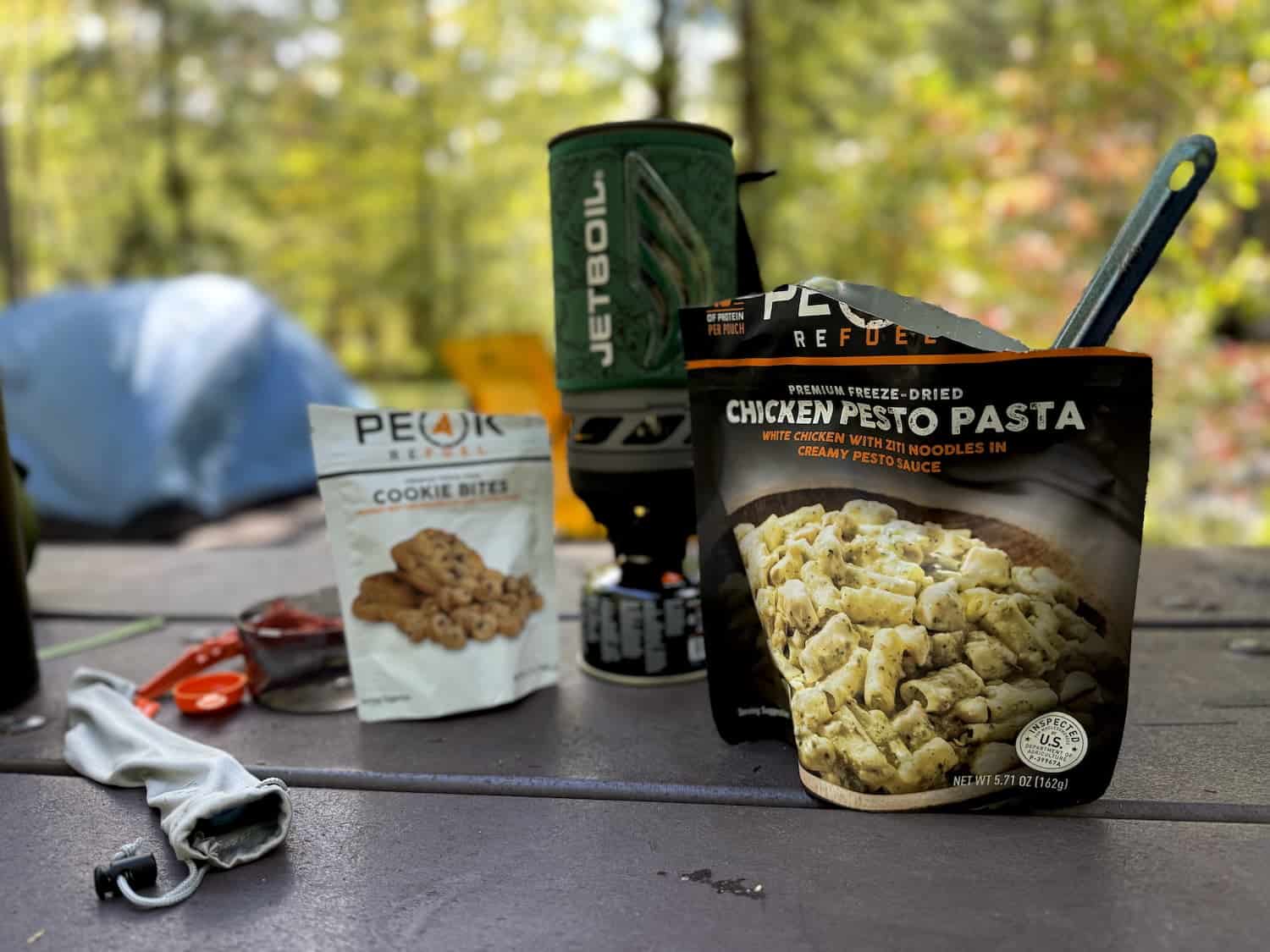
Snacks and Hydration
Energy levels can deplete quickly during physically demanding caving activities, so bringing high-energy snacks and sufficient water is beneficial. You may not want to bring food for smaller cave trips, but they become very beneficial in longer cave trips (or if a rescue is needed).
Pack lightweight, non-perishable snacks such as protein bars, trail mix, or dried fruits that can be easily consumed without much preparation. A collapsible water bottle saves space and ensures you stay hydrated throughout your adventure. Keep these items readily accessible but secure within your pack to avoid losing them in tight spaces.
A Nalgene water bottle is great for storing all sorts of smaller-sized cave gear. Here’s an example.
Personally, I enjoy bringing two Hydroflasks with me when caving. One holds an energy drink, and the other holds water. They keep the drinks cold for long periods, which is how I like it.
Tips
- Have a filtered water bottle? Avoid using it with cave water. Using a filtered water bottle with cave water can be risky because cave water may contain contaminants that standard portable water filters cannot effectively remove.
- Please respect caves and follow a leave no trace policy. A simple bag of chips left behind in a cave can cause a drastic change in an environment. Don’t believe me? Here’s how one bag of chips disrupted a cave ecosystem.
Elbow Pads
Elbow pads are an excellent addition to your caving gear collection, especially for those planning to traverse rugged or narrow passages. Crawling on uneven surfaces or squeezing through tight spaces can take a toll on your elbows, leading to bruises or skin abrasions. A quality pair of elbow pads can help cushion the impact and protect against scrapes.
Look for lightweight, low-profile options that won’t restrict your movement or add unnecessary bulk. Many cavers recommend using pads designed for sports or tactical activities as they tend to provide a good combination of durability and comfort. While elbow pads might not always be necessary, they can be a lifesaver during longer or more challenging explorations.
Tips
- Ensure your elbow pads fit snugly and stay in place without sliding around during movement to maximize their protective benefits.
- Some elbow pads are designed to go under your clothing while others are designed to go on the outside of your clothing. This comes down to personal preference.
Wet Suits
If you’re knowledgeable on wet suits and can help me create this section, please let me know.

Action Cams
Modern mobile phones can take great photos and videos in a cave, but sometimes, an action cam that you attach to your helmet makes capturing these thrilling moments more convenient. Capturing your cave exploration with an action camera can be a fantastic way to relive the adventure or share it with others.
Many will recognize the GoPro brand, but there are better options. You’re better off getting an Insta360 Ace Pro 2 or the Osmo Action 5 Pro. These action cams handle low-light situations better. Use their dedicated low-light video modes for even better video performance.
These action cams are excellent choices due to their durability, compact size, and ability to record decent video in low-light conditions. Attach your action cam to a helmet mount for hands-free recording, ensuring you can focus on navigating the cave while keeping your camera secure.
Tips
- Remember to respect the cave’s environment and avoid placing your equipment in areas that could cause damage to formations.
- Test your camera settings before entering the cave to optimize video quality for low-light settings, and always double-check your mount’s stability to avoid losing valuable footage—or the camera itself!
- It’s okay to share photos and videos of your caving adventures online, but do NOT share cave locations online! Do everything you can to protect these vital resources. Time and time again, a cave becomes well-known and gets destroyed by the general public who does not understand the importance of conservation, preservation, and safety. This can lead to cave closures, which no one wants.
- This isn’t about action cams, but many caves are located on private property, and landowners often have security cameras in place. Never assume you’re alone. Always respect private property and tread carefully—carelessness can lead to landowners restricting access to caves. Be mindful and responsible to help preserve access for everyone.
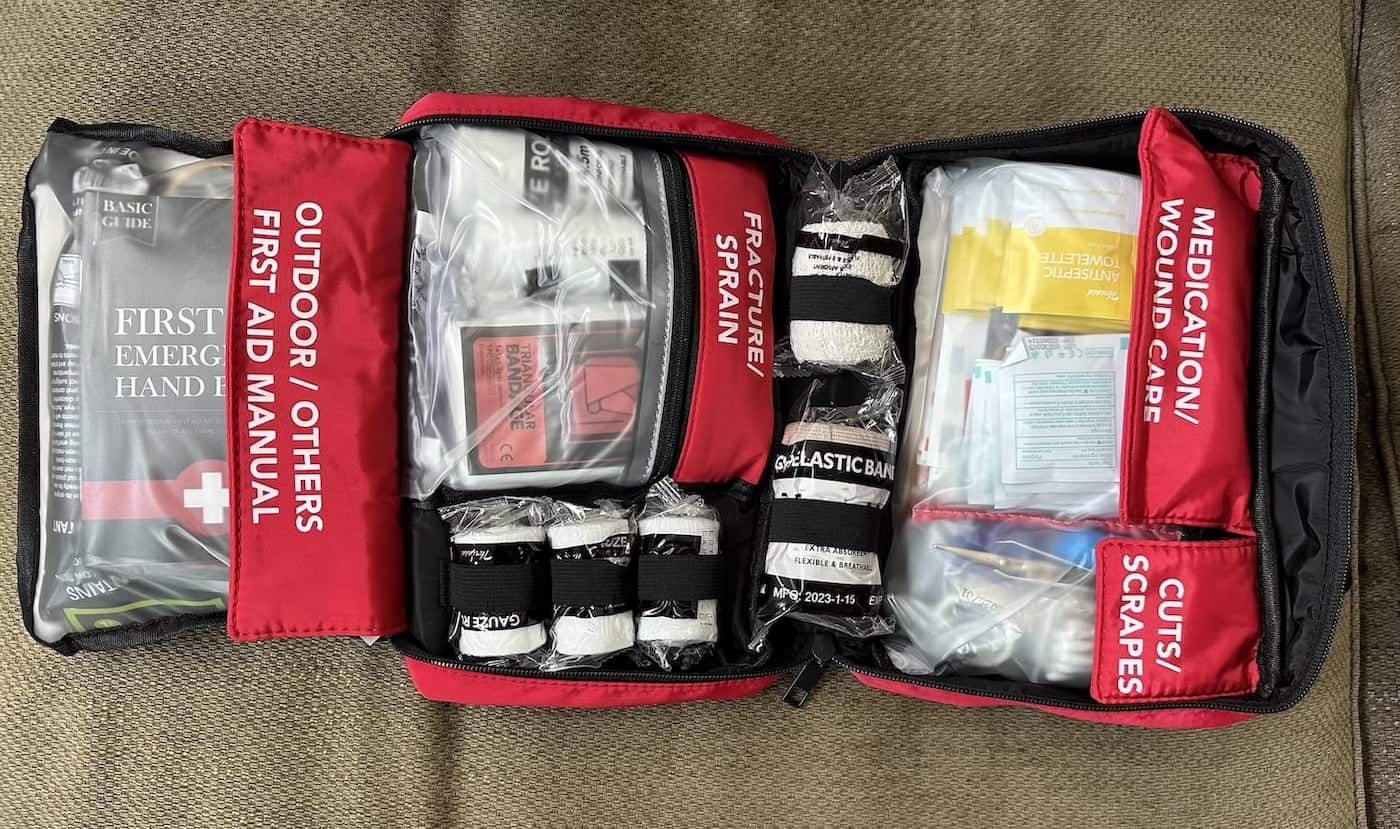
First-Aid Kits
A first-aid kit can be an essential part of any caving expedition, regardless of its duration or complexity. That being said, you may not always feel the need to bring one, as a trip leader may carry one (never assume this, though).
I know plenty of cavers consider this an essential item, but I also understand that not everyone will bring one. Try to ensure that at least one person on your trip brings a first aid kit.
Underground environments are unpredictable, and even minor injuries such as cuts, scrapes, or bruises can become problematic if left untreated. Your kit should include basic supplies like adhesive bandages, antiseptic wipes, gauze, a glow stick or reflectors, medical tape, duct tape to repair ripped clothing or blown-out boots, and an emergency blanket. An emergency blanket can prevent hypothermia when cold, wet, and injured or be used to drag someone who is injured or too scared to crawl through a tight passage.
Additionally, consider packing items like pain relievers, blister pads, flagging tape to mark archeological finds or even mark your route, and an elastic bandage for minor sprains. For lengthier or more remote trips, include advanced items such as a trauma bandage and a whistle to signal for help.
Opt for a compact and waterproof first-aid kit to save space and weight. Familiarize yourself with the contents of the kit beforehand so you can respond quickly during an emergency. You may also enjoy taking a basic first-aid training course to enhance your preparedness for potential injuries underground. Remember, safety is paramount, and having the right tools on hand can make all the difference in an emergency.
Want to enjoy a cave to yourself? Bring an Aztec Death Whistle. This whistle sounds like a monster screaming. If you ever wanted to scare someone from entering a cave, this whistle will likely do the trick so your group can enjoy a cave to yourselves (This is mostly a joke, but still factual).
Tip: This is not an exhaustive list of items to bring in your first-aid kit. This is just a starting point.

Cave Maps
Some caves are small, and you might feel that a cave map is unnecessary. However, there are caves that can extend for tens of miles and be very maze-like. Having a cave map can significantly reduce your chances of getting lost.
In many cases, your trip leader will offer to provide a cave map before entry.
Tip: When caving, make sure to occasionally look behind you to see how the cave appears. Many caves look completely different on your way out. Looking back helps you recognize features and prevents getting lost.
Vertical Caving Gear
If you’re knowledgeable on vertical gear and can help me create this section, please let me know.
Other Items
Spare Clothing For After Parties
Remember to pack a change of clothes for after your cave trip. Exploring caves tends to work up quite an appetite, and you’re not alone if you find yourself craving a hearty meal afterward. It’s common for caving trips to wrap up with a visit to a nearby restaurant—Mexican cuisine is a popular choice. Having clean, dry clothes ready will make your post-caving celebration all the more comfortable and enjoyable.
Tip: Always bring spare clothes, including shoes. On one of my first cave trips, I didn’t think I’d get that wet. Next thing I know, I fell in a hole at the bottom of a waterfall. I was soaked neck to toe and had to eat at a restaurant while wet and cold.
Bathroom Etiquette
You didn’t think I’d skip bathroom breaks, did you? Sure, going to the bathroom in a cave isn’t the Instagrammable part of your caving adventure, but let’s face it—when nature calls, it doesn’t care if you’re 200 feet underground. Avoid the panicked scramble by packing a wag bag (or a pee bottle—yes, even that old water bottle can step up for the job). Handle your “business” like the seasoned cave explorer you are becoming.
Tip: Peeing in a moving stream? Generally considered okay. Peeing in stagnant water? Big no-no. Want to earn extra points as a cave conservation hero? Stick to using a wag bag. Not only does it preserve the cave for future adventurers, but it also keeps things a little less… aromatic. Because no one wants to stumble upon yesterday’s “nature call” in the middle of their epic underground journey. Stay classy, cavers!

Travel Tips
You need to drive to a cave, so why not make that experience more enjoyable? Here are some tips for making your drive to and from a cave more enjoyable.
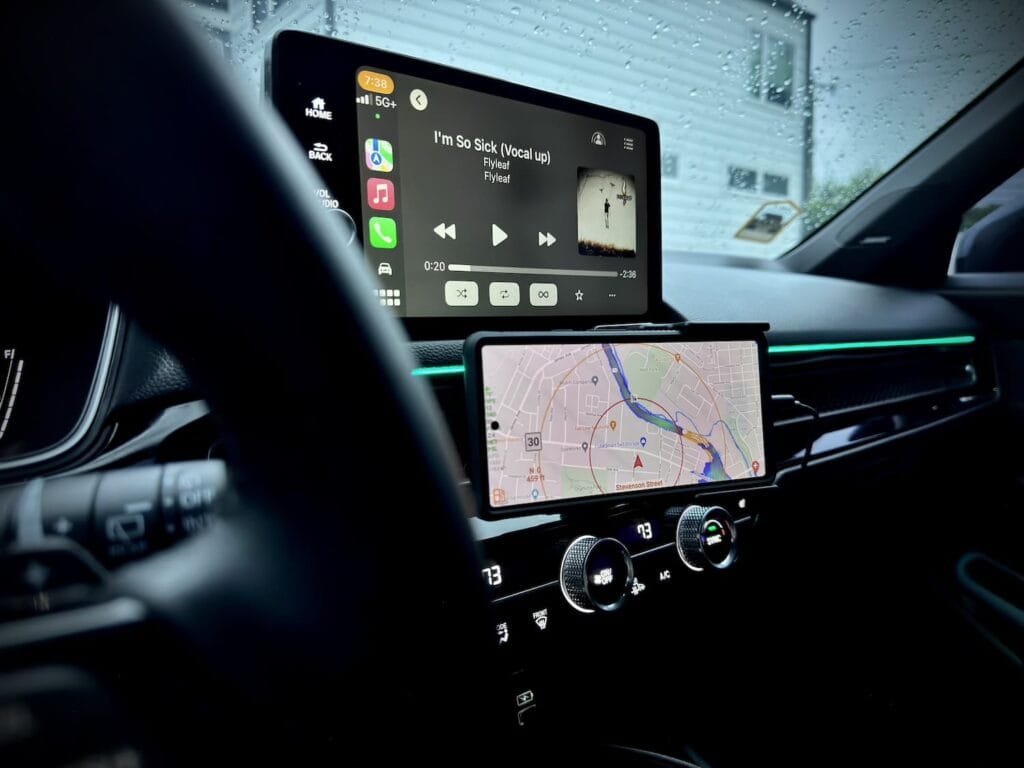
Offline Maps/Music
Many caves are in remote locations, which may not have cell service. When using GPS, download the route/map offline so you always have directions at your disposal.
Do you listen to music on your drive? Download your music for offline use so you can enjoy headbanging in peace all the way to a cave.


Who needs a 5-star resort when you’ve got these views?
Travel Apps
During travel, you can use apps to alert you to traffic jams, police checking for speeders, etc. Waze is a popular option for useful alerts. Wish there was a Waze on steroids option that alerts you to a million different things, including po-po in the sky looking for speeders? I won’t diverge the details here, but if you do some research, there is an app for that.
Lawn Chairs
Do you plan on having a cookout after a cave trip? Bring a lawn chair, so you have somewhere to sit if there aren’t any tables. Or maybe you find a beautiful overlook and want to enjoy the view for a bit.
Wireless Battery Pack
Going in a wet or especially muddy cave? Water or mud may get in your phone’s charging port, preventing it from being usable on your way home. If your phone supports wireless charging, bring a wireless battery pack so you can charge your phone wirelessly on the way home, even if your charging port can’t be used.


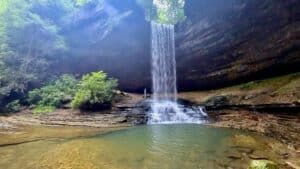
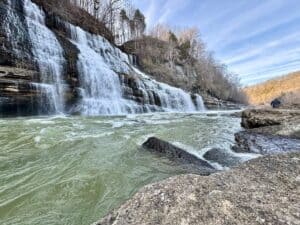

Chasing waterfalls like TLC told me not to.
Hiking App
Enjoy hiking? Utilize the AllTrails app (IOS) (Play Store) to find trails near a cave. Sign up for their Pro plan to download offline maps so you never get lost. I’ve used this app to find amazing trails all across Tennessee. Thanks to this app, I’ve even stumbled upon an unknown cave and found an abandoned town. Some state-owned cave trails are also on AllTrails.
Ride-Sharing
Sometimes, a cave trip is hours away. If you don’t want to drive, ask others on the trip if you can share a ride with them. This may be necessary if there isn’t much parking at a cave.
Callouts
Don’t forget to designate a callout! A callout person is someone who knows where you are going and when you plan to be back. This person will call 911 if you don’t contact them by the time you specify. This is vital for cave rescues. Click here to view my Callout Form. Feel free to copy and adjust the form to your needs. While this isn’t gear-related, it’s a good reminder.
Park Respectfully
When parking near a cave, follow any rules/signs on the property. Respect landowner and state property rules and regulations. Try to park smart so others have room to park, and you avoid door dings.
Phew, that was a lot of information to take in, but I haven’t even gotten to the best part!

What About Discounts?
Now that you’re familiar with cave gear and its advantages, let’s discuss something even better—discounts!
Discounts For Miltary, Nurses, Firefighters, EMT, and Police
Military members, veterans, nurses, firefighters, EMTs, and police officers can unlock an incredible range of exclusive discounts. Two major discount platforms are available specifically for those who qualify.
Start with ID.ME, a free platform where you can create an account and verify your eligibility to access exclusive discounts. From top brands to travel, cruises, and more, it’s your gateway to incredible savings.
Next, check out Govx.com. By creating a free account and verifying your eligibility, you can access exclusive discounts across a variety of outdoor brands and products. The site features great deals on outdoor gear and offers savings on a wide range of other items.
NSS Discounts
Not a member of the National Speleological Society (NSS) yet? Joining comes with a great perk—exclusive discounts on gear!
NSS members can create a free account on expertvoice.com. Sign up with your NSS number, and within 48 hours, you’ll get access to a plethora of discounts on different outdoor brands. While I’m not allowed to share specific deals, I can tell you that you can get discounts up to 40% off MSRP.
NSS members also enjoy other benefits. Learn more about NSS benefits here.
Check For Coupon Codes
You don’t need to purchase everything on Amazon. You can often find better deals directly from a vendor’s website.
When purchasing from a vendor’s website, don’t forget to search for coupon codes!
- A quick Google search for a coupon code has gotten me 20%+ discounts more times than I can count.
- Many vendors will send you coupons if you sign up for their email or SMS lists.
- Some vendors have rewards accounts, which can be beneficial if you like products from a specific vendor.
Searching for coupon codes before making an online purchase saves you money that could be better spent on more gear. Maybe you missed the last cave trip… that doesn’t mean you need to miss the next good deal.
Why pay full price when a quick search can help you score a better deal?
REI Member Discounts
If you go hiking or like outdoor gear in general, REI can be a great resource. For a one-time purchase, you can join their Co-Op, which unlocks a bunch of deals on outdoor gear.
Co-Op members also receive a 20% discount on gear about four times per year. This discount can come in handy if you’ve been meaning to purchase something but kept putting it off and need a good reason to pull the trigger.
Company Discounts
If you work for a large corporation, there’s a chance one of your benefits includes a discount program, such as Perks At Work. Check to see if any gear you want to buy is discounted through any discount programs your company supplies you.
Fuel Discounts
Most gas stations have rewards programs. Download their apps, create an account, and utilize their rewards programs to save money on every fuel up. The 7/11 rewards program can be particularly beneficial in getting you steep fuel discounts.
Want even more fuel savings? Combine your gas station rewards with discounts from the Gasbuddy or Upside apps for some serious coupon-stacking superpowers.
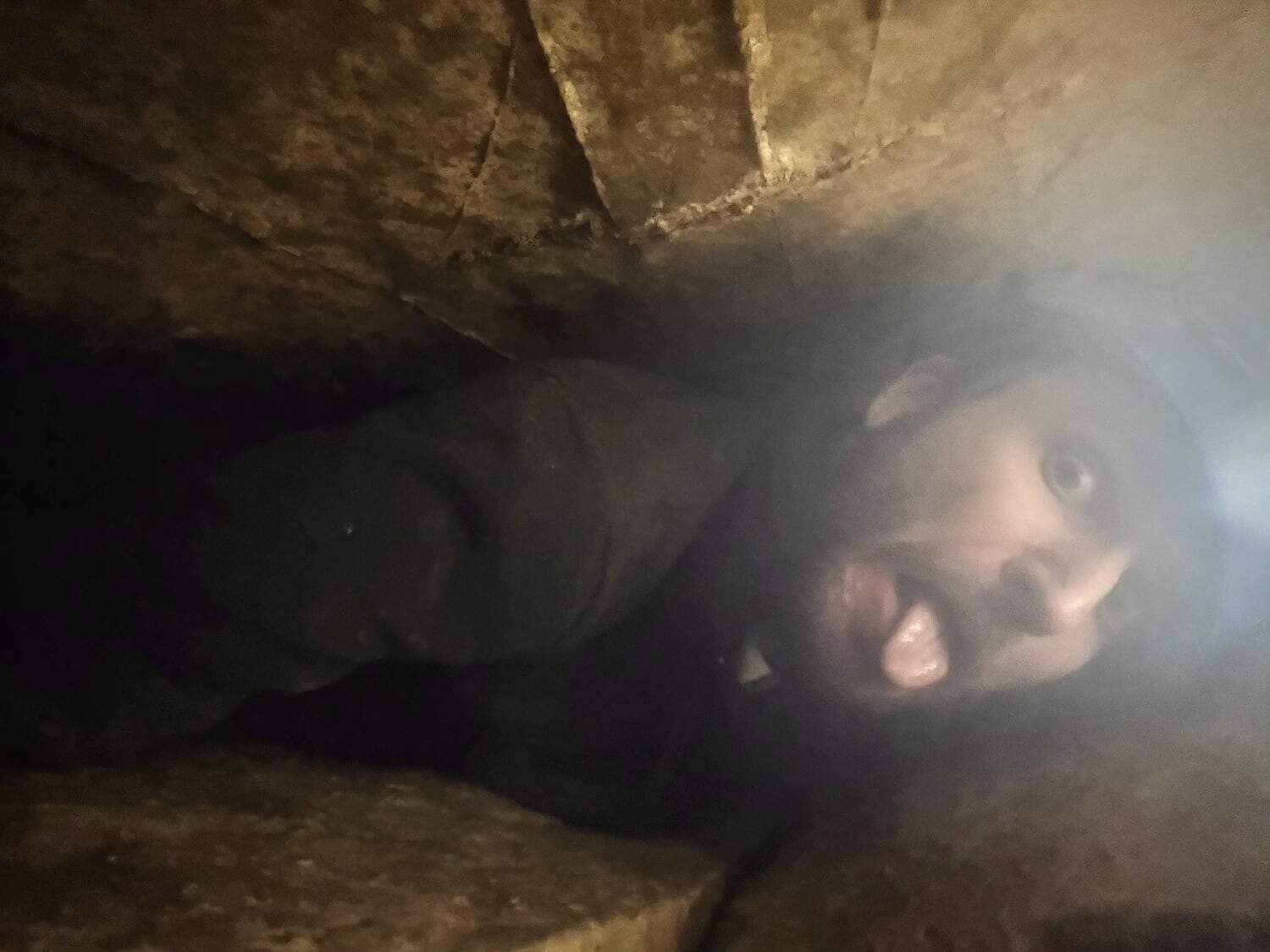
Let’s Go Caving
Now that you have your gear (and a discount) let’s find and explore caves while preserving this wonderful resource. I’ll see you underground or on a cliff edge soon!
